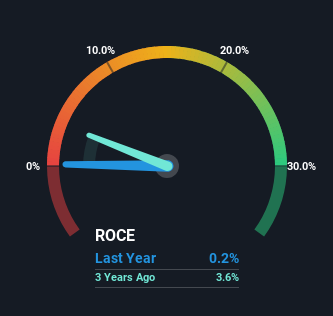Be Wary Of Ranhill Utilities Berhad (KLSE:RANHILL) And Its Returns On Capital
Ignoring the stock price of a company, what are the underlying trends that tell us a business is past the growth phase? A business that's potentially in decline often shows two trends, a return on capital employed (ROCE) that's declining, and a base of capital employed that's also declining. This reveals that the company isn't compounding shareholder wealth because returns are falling and its net asset base is shrinking. So after we looked into Ranhill Utilities Berhad (KLSE:RANHILL), the trends above didn't look too great.
Return On Capital Employed (ROCE): What Is It?
For those who don't know, ROCE is a measure of a company's yearly pre-tax profit (its return), relative to the capital employed in the business. The formula for this calculation on Ranhill Utilities Berhad is:
Return on Capital Employed = Earnings Before Interest and Tax (EBIT) ÷ (Total Assets - Current Liabilities)
0.0015 = RM3.3m ÷ (RM3.0b - RM765m) (Based on the trailing twelve months to December 2023).
Thus, Ranhill Utilities Berhad has an ROCE of 0.2%. In absolute terms, that's a low return and it also under-performs the Water Utilities industry average of 6.9%.
See our latest analysis for Ranhill Utilities Berhad
Above you can see how the current ROCE for Ranhill Utilities Berhad compares to its prior returns on capital, but there's only so much you can tell from the past. If you'd like to see what analysts are forecasting going forward, you should check out our free analyst report for Ranhill Utilities Berhad .
The Trend Of ROCE
In terms of Ranhill Utilities Berhad's historical ROCE movements, the trend doesn't inspire confidence. To be more specific, the ROCE was 7.7% five years ago, but since then it has dropped noticeably. On top of that, it's worth noting that the amount of capital employed within the business has remained relatively steady. This combination can be indicative of a mature business that still has areas to deploy capital, but the returns received aren't as high due potentially to new competition or smaller margins. If these trends continue, we wouldn't expect Ranhill Utilities Berhad to turn into a multi-bagger.
What We Can Learn From Ranhill Utilities Berhad's ROCE
In the end, the trend of lower returns on the same amount of capital isn't typically an indication that we're looking at a growth stock. Investors must expect better things on the horizon though because the stock has risen 9.9% in the last five years. Either way, we aren't huge fans of the current trends and so with that we think you might find better investments elsewhere.
If you'd like to know more about Ranhill Utilities Berhad, we've spotted 3 warning signs, and 1 of them is potentially serious.
If you want to search for solid companies with great earnings, check out this free list of companies with good balance sheets and impressive returns on equity.
Have feedback on this article? Concerned about the content? Get in touch with us directly. Alternatively, email editorial-team (at) simplywallst.com.
This article by Simply Wall St is general in nature. We provide commentary based on historical data and analyst forecasts only using an unbiased methodology and our articles are not intended to be financial advice. It does not constitute a recommendation to buy or sell any stock, and does not take account of your objectives, or your financial situation. We aim to bring you long-term focused analysis driven by fundamental data. Note that our analysis may not factor in the latest price-sensitive company announcements or qualitative material. Simply Wall St has no position in any stocks mentioned.

